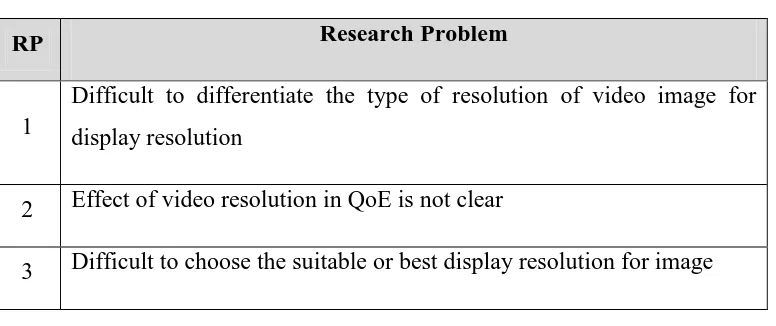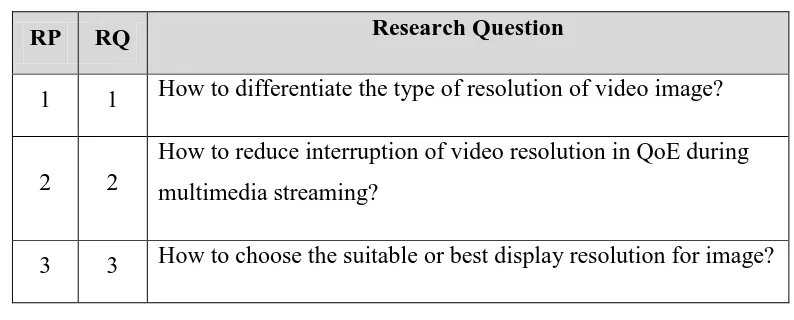i
DECLARATION
I hereby declare this project report entitled
EFFECT OF THE VIDEO RESOLUTION ON QUALITY OF EXPERIENCE IN WIRELESS MULTIMEDIA STREAMING
is written by me and is my own effort and that no part has been plagiarized without citations.
STUDENT :_____________________________ Date:_____________
(NOOR AZIE IZZATI BINTI NOOR AZMAN)
SUPERVISOR:_____________________________ Date:_____________
ii
DEDICATION
This work is dedicated to my beloved family and siblings, who passed on a love of reading and respect for education.
iii
ACKNOWLEDGEMENTS
Alhamdulillah, Thanks to Allah SWT, because give me opportunity to complete my Final Year Project which is title Effect of the Video Resolution on Quality of Experience in Wireless Multimedia Streaming. This final year project report was prepared for Faculty of Information and Communication Technology (FTMK), Universiti Teknikal Malaysia Melaka (UTeM), basically for student in final year to complete the undergraduate program that leads to the degree of Bachelor of Computer Science.
First of all, I would like to thanks to, my supervisor, Dr. Zul Azri Muhamad Noh for his technical guidance and valuable time in assisting us in the accomplishing these project. I also want to thanks to all lecturers for their cooperation, valuable information, suggestions and guidance in the compilation and preparation to complete the final year project report.
iv ABSTRACT
v ABSTRAK
vi
TABLE OF CONTENTS
DECLARATION ... i
DEDICATION ... ii
ACKNOWLEDGEMENTS ... iii
ABSTRACT ... iv
ABSTRAK ... v
LIST OF TABLES ... x
LIST OF FIGURES ... xii
LIST OF ABBREVATIONS ... xv
CHAPTER 1 ... 1
INTRODUCTION ... 1
1.1. Project Background ... 1
1.2. Problem Statement ... 2
1.3. Objective ... 4
1.4. Scope ... 5
1.5. Project Significant ... 5
1.6. Report Organization ... 6
1.7. Conclusion ... 7
CHAPTER II ... 8
LITERATURE REVIEW... 8
2.1 Introduction ... 8
2.2 Related work ... 9
2.2.1 Multimedia Streaming ... 9
2.2.2 Streaming Video ... 11
2.2.3 Quality of Experience (QoE) ... 11
vii
2.3 Analysis of current problem ... 13
2.4 Proposed Solution ... 13
2.5 Conclusion ... 14
CHAPTER III ... 15
METHODOLOGY ... 15
3.1 Introduction ... 15
3.2 System Development ... 16
3.2.1 Phase I: Literature Review ... 17
3.2.2 Phase II: Analysis ... 17
3.2.3 Phase III: Design ... 17
3.2.4 Phase IV: Implementation ... 17
3.2.5 Phase V: Testing and Evaluation ... 18
3.3 Activities Involved ... 18
3.3.1 Milestone ... 18
3.3.2 Gantt Chart ... 23
3.4 Conclusion ... 24
CHAPTER IV ... 25
DESIGN & IMPLEMENTATION ... 25
4.1 Introduction ... 25
4.2 Hardware and Software requirements ... 26
4.2.1 Hardware requirement ... 26
4.2.1.1 Laptop ... 26
4.2.1.2 Wireless Access Point ... 27
4.2.2 Software requirement ... 28
4.2.2.1 Search Everything ... 28
4.2.2.2 VideoLan Client (VLC) ... 29
viii
4.2.2.4 DVD Knife ... 31
4.2.2.5 Wireshark ... 32
4.3 Network Architecture ... 33
4.3.1 Logical design ... 33
4.3.2 Physical design ... 34
4.3.3 Network design ... 35
4.4 Implementation ... 36
4.4.1 Install the VideoLan Client ... 36
4.4.2 Install the MyFFVideoConverter ... 38
4.4.3 Install the DVDKnife ... 38
4.4.4 Install the Search Everything ... 39
4.4.5 Install wireshark ... 41
4.4.6 Results (using MyFFVideoConverter without streaming)... 42
4.5 Conclusion ... 47
CHAPTER V ... 48
TESTING ... 48
5.1 Introduction ... 48
5.2 Test Plan ... 49
5.2.1 Test Environment ... 49
5.2.2 Test Schedule ... 50
5.3 Test Design ... 51
5.4 Test Result and Analysis ... 51
5.4.1 Video Stream on Client PC ... 52
5.4.2 Data Analysis ... 57
5.4.2.1 QoE Rate ... 57
5.4.2.2 Delay Variation ... 59
ix
5.5 Conclusion ... 64
CHAPTER VI ... 65
CONCLUSION ... 65
6.1 Introduction ... 65
6.2 Research Summarization ... 65
6.3 Limitation ... 66
6.4 Contribution ... 66
6.5 Future Works ... 67
6.6 Conclusion ... 67
x
LIST OF TABLES
Table 1.2.1: Research Problem ... 2
Table 1.2.2: Research Question ... 3
Table 1.3.1: Research Objective ... 4
Table 3.3.1.1: PSM 1 ... 18
Table 3.3.1.2: PSM 2 ... 21
Table 5.2.1: Hardware ... 49
Table 5.2.1 : Software ... 50
Table 5.2.2.1: Test schedule ... 50
Table 5.4.2.1.1: Result ... 57
Table 5.4.2.1.2: Score ... 57
Table 5.4.2.1.3: Formula of Mean... 58
Table 5.4.2.2.1: 128x196 video resolutions ... 59
Table 5.4.2.2.2: 320x200 video resolutions ... 59
Table 5.4.2.2.3: 640x350 video resolutions ... 59
Table 5.4.2.2.4: 720x576 video resolutions ... 60
Table 5.4.2.2.5: 1024x768 video resolutions ... 60
Table 5.4.2.2.6: Formula of Delay ... 60
Table 5.4.2.3.1: 128x196 video resolutions ... 62
Table 5.4.2.3.2: 320x200 video resolutions ... 62
xi
xii
LIST OF FIGURES
Figure 2.2.1.1.: Process of Streaming stored Multimedia ... 9
Figure 2.1.1.2: Process of Client Buffering ... 10
Figure 2.1.1.3: Principle of Streaming ... 10
Figure 3.2.1.: Waterfall Model for overall project ... 16
Figure 3.3.2.1: Gantt Chart ... 23
Figure 4.2.1.1.1: Laptop ... 26
Figure 4.2.1.2.1: TP-Link ... 27
Figure 4.2.2.1.1: :Interface of search box Search Everything ... 28
Figure 4.2.2.2.1: Interface of VideoLan Client player ... 29
Figure 4.2.2.3.1: Interface of MyFFVideoConverter ... 30
Figure 4.2.2.4.1: Interface of DVDKnife 4.0 ... 31
Figure 4.2.2.5.1: Interface of Wireshark ... 32
Figure 4.3.1.1: Logical design... 33
Figure 4.3.2.1: Physical design ... 34
Figure 4.3.3.1: Network design ... 35
Figure 4.4.1.1: Choosing destination ... 36
Figure 4.4.1.2: Add Stream at the path ... 37
Figure 4.4.1.3: Video that has been play ... 37
Figure 4.4.2.1: Interface of MyFFVideoConverter ... 38
xiii
Figure 4.4.4.1: Viewer of Everything Options ... 39
Figure 4.4.4.2: Copy the URL ... 40
Figure 4.4.4.3: Play the video ... 40
Figure 4.4.5.1: Interface of Wireshark ... 41
Figure 4.4.6.1:Interface of MyFFVideoConverter ... 42
Figure 4.4.6.2: Video that be compared ... 43
Figure 4.4.6.3: Choose the resolution ... 43
Figure 4.4.6.4: Video in 320x200 resolution ... 44
Figure 4.4.6.5: Choose resolution ... 44
Figure 4.4.6.6: Video that been compared in 640x350 ... 45
Figure 4.4.6.7: Change the resoulution ... 45
Figure 4.4.6.8: Video in 720x576 resolution ... 46
Figure 4.4.6.9: Change resolution in the other setting ... 46
Figure 4.4.6.10: The highest resolution ... 47
Figure 5.4.1.1.: Size of video in 128x196 ... 52
Figure 5.4.1.2: Size of video in 320x200 ... 53
Figure 5.4.1.3: Size of video in 640x350 ... 534
Figure 5.4.1.4: Size of video in 720x576 ... 535
Figure 5.4.1.5: Size of video in 1024x768 ... 536
Figure 5.4.2.1.1 : QoE Rate ... 58
xiv
xv
LIST OF ABBREVATIONS
AVI Audio Video Interleave
CD Compact Disc
CPU Cental Processing Unit DVD Digital Versatile Disk
Fps Frames per second
GB Gigabyte
GHz GigaHertz
H.264 , DIV3, MPEG-4
HTTP Hypertext Transfer Protocol
IP Internet Protocol
MPEG Moving Picture Expert Group
NTFS Network Technology File System
PC Personal Computer
Ppi Pixels per inch
PSM Projek Sarjana Muda
QoE Quality of Experience
RAM Random Access Memory
RO Research Objective
RP Research Problem
RQ Reserarch Question
xvi
VLC VideoLan Client
VOB Video Object
1 CHAPTER 1
INTRODUCTION
1.1.Project Background
2
In addition, the display resolution of a digital television, computer monitor or smart phone is a measurement of the number of pixels displayed on screen. Two types of video resolution are spatial and temporal. Spatial resolution is total number of pixels contained in each individual frame while, temporal resolution is number of frames per second. To compensate jitter variance of the end to end delay at the receiver, a portion of the received data is buffered in a play-out buffer. The video content is rendered on the screen with the signalized frame rate, making the inter-packet arrival time variations invisible for the user. Therefore, the end user quality for video streaming does not depend on the absolute end to end delay. Thus, video streaming is usually referred to as real time service.
1.2.Problem Statement
Nowadays, there are many problems to differentiate the resolution in high definition image format and standard definition image format. This characteristic causes the difficulty to maintain and choose the best resolution video image. The Research Problem is summarized into Table 1.1. Table 1.2 shows the research problems and research questions in this project.
Table 1.2.1: Research Problem
RP Research Problem
1
Difficult to differentiate the type of resolution of video image for display resolution
2 Effect of video resolution in QoE is not clear
3
Table 1.2.2: Research Question
RP RQ Research Question
1 1 How to differentiate the type of resolution of video image?
2 2
How to reduce interruption of video resolution in QoE during multimedia streaming?
3 3 How to choose the suitable or best display resolution for image?
RQ1: How to differentiate the perceived sharpness of image?
This research question is formulated by considering on the type of resolution of image issue which is high definition resolution and standard definition resolution as highlighted in RP1 in Table 1.1. This RQ1 is the primary guides to formulate the research objectives (RO1) of this project.
RQ2: How to reduce interruption of video resolution in QoE during multimedia streaming?
This research question is formulated by considering the performance of Quality of Experience to reduce interruption of video resolution issue during streaming as highlighted in RP2 in Table 1.1. This RQ2 is the primary to formulate the research objectives (RO2) of this project.
RQ3: How to choose the suitable or best display resolution for image?
4
1.3.Objective
Table 1.3.1: Research Objective
RP RQ RO Research Objective
1 1 1 To study the effect of video resolution in performance on QoE 2 2 2 To monitor the delay and throughput during video streaming 3 3 3 To identify the suitable or best display resolution for image
RO1: To study the effect of video resolution in performance on QoE
After determine the size of video resolution, we measured the image in difference resolution based on size of resolution that has been analyzed.
RO2: To monitor the delay and throughput during video streaming
After get the video, we monitor the delay and throughput during stream session.
RO3: To identify the suitable or best display resolution for image
5
1.4.Scope
This project is to analyze the effect of the video resolution on quality of experience in wireless multimedia streaming. Scope of project is going to be conducted as follows:
a) Size of video
- Size of video to at least 128x196 pixels at 25fps.
b) Quality of video
- Depends on size of video and difference resolution of video that will be used.
c) Difference resolution of video
- Difference standards of resolution.
d) Same compression
- Will analyze in difference type of resolution but with the same compression.
1.5.Project Significant
The idea is to analyze the effect of the video resolution on quality of experience in wireless multimedia streaming when each video streaming using difference
6
1.6.Report Organization
i. Chapter 1: Introduction
This chapter will discuss the introduction, project background, research problem, research question, research objective, scope, project significant and report organization.
ii. Chapter 2: Literature Review
Next chapter will explain the related work of this project, such as size of video resolution, quality of video and type of resolution.
iii. Chapter 3: Methodology
This chapter will explain the method to use in analyze the resolution video and organize the sequence of project in phase by phase.
iv. Chapter 4: Design and Implementation
This chapter will introduce the software and hardware use in this project, environment setup, implementation of personal computer as well as the sample data collected.
v. Chapter 5: Testing and Analysis
Next chapter will analyze the data that has been collected and will carry out to support the result.
vi. Chapter 6: Conclusion


